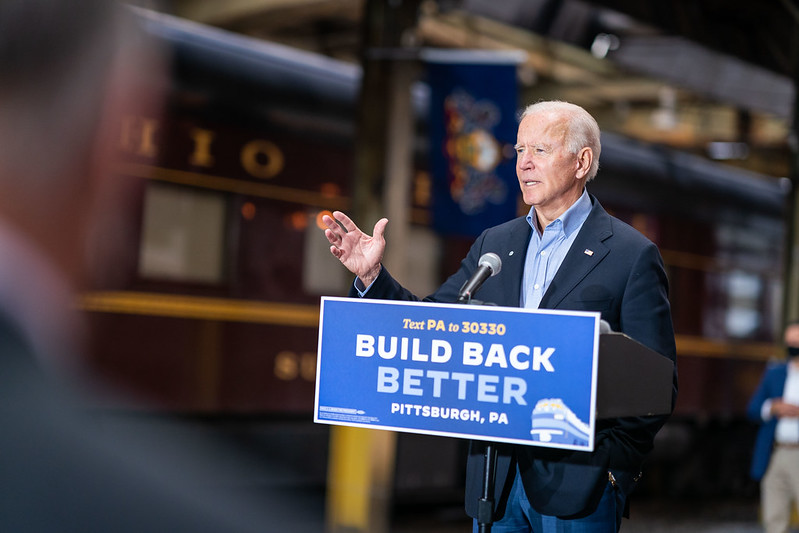
The president-elect made all the right campaign promises – but other presidents said the same thing. Here’s what Biden needs to do to make good on his word.
Editor’s note: This is the second entry in our 10-part series examining the policies and priorities that President-elect Joe Biden should focus on as he looks to lead America out of the COVID-19 pandemic and rebuild the American economy.
The COVID-19 pandemic has caused unfathomable pain for Americans both from a health and an economic standpoint. The “v-shaped” recovery being celebrated by Wall Street has not been shared by hundreds of thousands of factory workers and their families, who have been left wondering how they will pay rent, let alone get back on their feet once a vaccine is available and we return to some semblance of our past “normal” lives.
Enter former Vice President Joe Biden, who on Jan. 20 is poised to enter the White House with an ambitious campaign plan to “Build Back Better,” with a target of creating “at least 5 million new jobs in manufacturing and innovation.” A core tenet of Biden’s plan is massive investment in infrastructure and clean energy aimed at putting Americans back to work and making America more competitive in the future.
President-elect Biden has also promised “to make a national commitment to Buy American – and make this promise real, not just rhetoric.” This is not a campaign promise that is new to American workers.
Just four years ago, President Trump entered the Oval Office promising a big infrastructure bill and said his administration would follow “two simple rules: Buy American and Hire American.”But, four years later, much work remains left to be done to broaden and more effectively implement Buy America policies applied to infrastructure spending.
“As part of its historic investment in infrastructure, Biden will strengthen and enforce Buy America,” states the Biden campaign website. So, what will it take for a Biden administration to fulfill this Buy America promise?
First, the administration must quickly identify and remedy infrastructure spending programs that are not covered by Buy America, or where coverage is limited with loopholes and narrow agency application. As president, Biden will have broad authority to address these deficiencies, which represent opportunities to fulfill his target of creating 5 million jobs in a manner 100 percent compliant with our international trade obligations.
Second, Biden must ensure that tax dollars spent on infrastructure use U.S.-made iron, steel, and manufactured products, the last of which, while required by law, have been effectively ignored in highway projects for the last 37 years. Frequently used construction materials like aluminum, plastics, lumber, and cement are made by American workers but not covered by Buy America because of an outdated nationwide waiver that must be revisited. It is estimated that less than 5 percent of the spending on a highway project of $1 million is covered by Buy America. Much of the other 95 percent of non-steel and -iron product purchases is wide open to foreign production.
Third, the Biden administration needs to actively identify Buy America loopholes and slam them shut without hesitation. For instance, Washington D.C.’s transit agency (WMATA) is currently using an accounting gimmick to evade Buy America laws for the purchase of hundreds of subway rail cars. The Trump administration has not taken action besides writing to “encourage” WMATA to comply with Buy America.
Fourth, Biden must ensure that “American-made” matters. Products merely assembled in the United States from foreign components should not qualify under Buy America, nor should foreign steel that undergoes only a finishing process here. Fortunately, Biden’s plan has emphasized that steel, iron, and manufactured products should be “melted, mined, and manufactured in the U.S.” Strong origin standards mean that American workers throughout U.S. supply chains will benefit when tax dollars are spent. Steel is made here only if it is melted here.
Finally, Buy America policies must be fully enforced and administered in a transparent manner so that the public understands how their hard-earned dollars are being spent. Waivers to Buy America should be fully explained and made public, so that domestic producers can fill orders before foreign goods are purchased. To make this process work more efficiently, Biden has pledged to expand “supplier scouting” activities to identify domestic firms able to source construction materials for our infrastructure.
Biden’s “Build Back Better” plan appears on track to pursue these important policies, but this work will not stop with executive orders and directives given to agencies during the first 30-, 60-, or 90-days. A sustained and unwavering commitment to American-made bridges, water systems, schools, and other public infrastructure is necessary. Investing in American-made infrastructure means jobs, a cleaner economy for the future, and enhanced national security and preparedness – all of which are desperately needed right now.
Fortunately, this is not a partisan issue. Both Republican and Democratic voters agree that Congress and the administration need to get to work on this issue, placing American-made infrastructure ahead of all other policies on their wish list.
Infrastructure investment is not only a smart move politically. Recent research by the Economic Policy Institute found up to 12.9 million new jobs could be created by investing in infrastructure and clean energy and rebalancing trade. Enhancing Buy America policies will only enhance those estimates.
With the backdrop of millions of Americans still unemployed – including 599,000 fewer manufacturing jobs since February – let us all hope that Congress can set aside its partisan gridlock to rally around investing in much-needed, American made infrastructure. Leadership from the White House will be required, and Biden will once again be in a key position to lead our nation out of a crisis – as was the case in 2009 when he and President Obama took office in the midst of the Great Recession.
Listen to Scott Boos talk about this blog on The Manufacturing Report.
